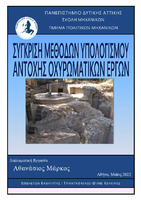| dc.contributor.advisor | Κόκκινος, Φίλης-Τριαντάφυλλος | |
| dc.contributor.author | Μάρκος, Αθανάσιος | |
| dc.date.accessioned | 2022-06-03T08:17:03Z | |
| dc.date.available | 2022-06-03T08:17:03Z | |
| dc.date.issued | 2022-05 | |
| dc.identifier.uri | https://polynoe.lib.uniwa.gr/xmlui/handle/11400/2307 | |
| dc.identifier.uri | http://dx.doi.org/10.26265/polynoe-2158 | |
| dc.description.abstract | Η παρούσα διλωματική μελετά και παρουσιάζει τον υπλογισμό της αντοχής οχυρώσεων του Β'ΠΠ χρησιμοποιώντας δύο διαφορετικών υπολογιστικών μεθόδων:Την εμπειρική μέθοδο σύμφωνα με το Τεχνικό Εγχειρίδιο ΤΕ 5-855-1 (Στρατός ΗΠΑ-1996) και τις ΟΜΟΕ (ΕΜΠ-2008) και συγκρίνει τις δύο αυτές μεθόδους.Το πρώτο κεφάλαιο είναι μία γενική εισαγωγή στην οχυρωτική και στον λόγο γιατί τα οχυρωματικά έργα στην πόλη της Ραφίνας είναι ιδανικά για την σύγκριση των δύο μεθόδων.Στο δεύτερο κεφάλαιο παρουσιάζονται τα διαφορετικά οχυρωματικά έργα της Ραφίνας και δύο από αυτά επιλέγονται για περαιτέρω ανάλυση.
Η αντοχή του σκυροδέματος και του οπλισμού υπολογίζονται με τη χρήση καταστροφικών μεθόδων και εργαστηριακών δοκιμών μονοαξονικής θλίψης και τάσης.Τελικά, επιλέγεται μία χαρακτηριστική διατομή από κάθε επιλεγθέν οχυρωματικό έργο για επιπλέον βαλιστική ανάλυση.Το τρίτο κεφάλαιο αναλύει τις απειλές και το όπλο σχεδιασμού.Στο τέταρτο και πέμπτο κεφάλαιο υπολογίζεται η μέγιστη διείσδυση σύμφωνα με τις υπολογιστικές μεθόδους των ΤΕ 5-855-1 και των ΟΜΟΕ, αντίστοιχα.Τέλος, το έκτο κεφάλαιο παρουσιάζει τα αποτελέσματα της σύγκρισης.Τα αριθμητικά αποτελέσματα αντιπαραβάλλονται με αναλυτικές λύσεις αποδεικνύοντας την αποτελεσματικότητα των δύο μεθόδων. | el |
| dc.format.extent | 85 | el |
| dc.language.iso | el | el |
| dc.publisher | Πανεπιστήμιο Δυτικής Αττικής | el |
| dc.rights | Αναφορά Δημιουργού - Μη Εμπορική Χρήση - Παρόμοια Διανομή 4.0 Διεθνές | * |
| dc.rights | Attribution-NonCommercial-NoDerivatives 4.0 Διεθνές | * |
| dc.rights.uri | http://creativecommons.org/licenses/by-nc-nd/4.0/ | * |
| dc.subject | Οχύρωση | el |
| dc.subject | Οχυρωματικό έργο | el |
| dc.title | Σύγκριση μεθόδων υπολογισμού αντοχής οχυρωματικών έργων | el |
| dc.title.alternative | Comparison of computational methods for evaluating the strength of fortifications | el |
| dc.type | Διπλωματική εργασία | el |
| dc.contributor.committee | Pnevmatikos, Nikos | |
| dc.contributor.committee | Δενεζάκη, Σταυρούλα | |
| dc.contributor.faculty | Σχολή Μηχανικών | el |
| dc.contributor.department | Τμήμα Πολιτικών Μηχανικών | el |
| dc.description.abstracttranslated | This diploma thesis studies and demonstrates the calculation of the strength of fortification from World War II using two different computational methods: The empirical method according to Technical Manual TM 5-855-1 (US Army-1996) and the analytical according to ΟΜΟΕ (National Technical University οf Athens-2008) and compares these two methods.The first chapter is an introduction of fortification in general and the reason why the fortification in the city of Rafinais the ideal for the comparison between the two computational methods.In the second chapter there is a presentation of the different forts of Rafina and two of them are further analyzed. The strength of concrete and steel elementsis calculated with the use of destructional methods and compression and tension testing.Additionally, the presentenceof steelis estimated by a typical cross sectionin the selected forts.Finally,one characteristic cross section from each selected fort is chosen for further ballistic analysis.Chapter three analyzes the threats and the weapon of design.Chapter four estimates the maximum penetration using computational method according to TM5-855-1.Chapter five estimates the maximum penetration using computational method according to OMOE.Finally,chapter six presents the conclusions from the comparison.The numerical results are compared to analytical solutions demonstrating the strength of the two methods. | el |


